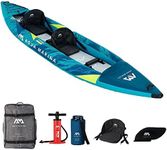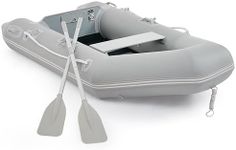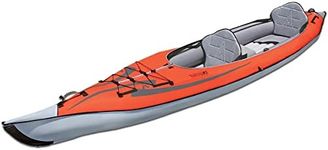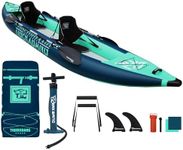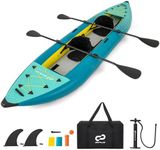Buying Guide for the Best Inflatable Kayak 2 Person
Choosing the right inflatable kayak for two people involves considering various factors that will ensure a safe, enjoyable, and comfortable experience on the water. Inflatable kayaks are a great option for those who need portability and easy storage, but it's important to understand the key specifications that will affect performance and usability. By focusing on these specifications, you can find a kayak that suits your needs, whether you're planning a leisurely paddle on a calm lake or an adventurous trip down a river.MaterialThe material of an inflatable kayak is crucial for its durability and performance. Common materials include PVC, Hypalon, and Nitrylon. PVC is lightweight and affordable, making it a popular choice for casual users. Hypalon is more durable and resistant to UV rays and chemicals, ideal for those who plan to use their kayak frequently or in harsh conditions. Nitrylon is eco-friendly and offers good abrasion resistance. Consider how often and where you will use the kayak to choose the right material. If you plan on frequent use or rough conditions, opt for more durable materials like Hypalon.
Weight CapacityWeight capacity indicates how much weight the kayak can safely hold, including passengers and gear. It's important to choose a kayak with a weight capacity that exceeds the combined weight of both paddlers and any additional equipment. Kayaks with higher weight capacities are suitable for carrying more gear, which is beneficial for longer trips. If you plan on short, casual outings, a lower weight capacity may suffice. Always ensure there's a comfortable margin between your total load and the kayak's maximum capacity to maintain stability and performance.
Length and WidthThe length and width of an inflatable kayak affect its speed, stability, and maneuverability. Longer kayaks tend to be faster and track better in a straight line, making them suitable for open water or long-distance paddling. Wider kayaks offer more stability, which is beneficial for beginners or those paddling in calm waters. Consider your paddling environment and experience level when choosing the dimensions. If you prioritize speed and efficiency, opt for a longer kayak. For stability and ease of use, especially in calm waters, a wider kayak is preferable.
ChambersInflatable kayaks are designed with multiple air chambers to enhance safety. If one chamber is punctured, the others can keep the kayak afloat. More chambers generally mean better safety and stability. Most inflatable kayaks have at least three chambers, but some models offer more. If safety is a top priority, especially in rough waters, choose a kayak with more chambers. For casual use in calm conditions, a standard three-chamber design may be sufficient.
Setup TimeSetup time refers to how long it takes to inflate and prepare the kayak for use. This can vary depending on the design and included pump. Quick setup times are convenient for those who want to spend more time on the water and less time preparing. If you value convenience and ease of use, look for kayaks with efficient inflation systems and included pumps that reduce setup time. For those who don't mind a bit of extra effort, a longer setup time might be acceptable if it means better performance or features.
PortabilityPortability is a key advantage of inflatable kayaks, as they can be deflated and packed into a compact size for easy transport and storage. Consider the packed size and weight of the kayak when deflated, especially if you plan to carry it over long distances or have limited storage space. Lighter and more compact models are easier to transport and store, making them ideal for those with limited space or who plan to travel frequently with their kayak. If portability is less of a concern, you might prioritize other features like durability or performance.





